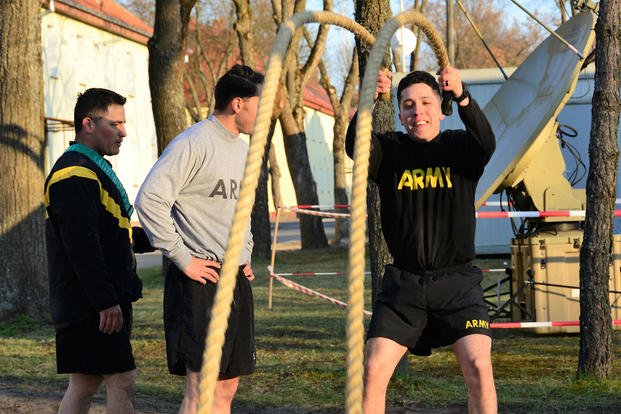Whether you are maintaining your fitness level for health or building yourself up to near optimal levels in preparation of sports, military or Special Ops screening programs, having a strong fitness foundation is required. Recently in an article discussing the Ten Things You Should Know before Joining the Military, having a fitness foundation was one of the top recommendations to succeed.
But what is a fitness foundation, and how should you build one? How should you develop and shape it to fit your goals? These are common questions I've recently received, but the answer is always simple: It depends. The definition of a fitness foundation will differ depending upon your goal, but basically a fitness foundation is your ability to perform your specific daily tasks at a certain level that is acceptable to you and your professional needs.
For instance, if you are going to play football next season and you're starting to train in December, you have about seven months before preseason practices start. You do not want to arrive on your first day of practice having not lifted weights, not worked on your speed and agility, or let go of any other position-driven skills you may need. You build your fitness foundation for the next season today. The specifics of this sport require you to be strong, gain weight and speed, and be a team player.
But some people are starting from scratch, with no fitness foundation other than genetics. You may be tall and skinny. You may be short and bulky. You may be a naturally huge specimen but never have trained before. Building your foundation really depends upon your specific needs. Once you build a fitness foundation, it is more possible to move along the fitness spectrum, trying different sports or taking a high school or college sports foundation and developing a military or Special Ops fitness level.
The most important component of a fitness foundation
Strength: In my opinion, strength is the component that allows all other elements of fitness to prosper, and for the tactical athlete, strength is an absolute must. Having a stable core (shoulder girdle, spine, hips) is critical to your growth as well for your ability to lift and carry your weight and more.
You will never see a tree with bigger limbs than its trunk, so start here in the gym and learn how to do squats, overhead lunges, deadlifts and build up to hang cleans and power cleans. These may require some coaching, but there are easier exercises if you are just starting out using dumbbells or sandbags. (Link to lifting options with dumbbells)
You can build strength in a variety of ways from lifting weights, kettlebells, sandbags, TRX, even calisthenics and heavy manual labor. It all depends on your current fitness level and your future goals to how you want to proceed. Basic lifting set and rep plans such as 3 x 5-8 reps or 5 x 5 (sets/reps) are a great place to start lifting and building strength over time.
Find the weight per exercise that will push you to barely achieve these repetitions each set. Over several months, with proper technique, start pushing heavier weights with 2-3 repetitions. Give yourself some time before you start lifting heavier one-rep maxes if you are new to lifting. Be patient; the strength foundation will come. You do not need to be a world-class powerlifter to be strong; just lift.
Endurance and muscle stamina: These two are close seconds to the athlete who is preparing for future challenging military or Special Ops training. Depending upon your athletic background, you might be an endurance super stud; maybe you run cross country and swim for your sport. You may have all the endurance you need to ace some programs, but you likely will be lacking in the strength category, so adding a calisthenics base -- followed by weightlifting cycles -- will benefit you quickly.
The powerlifting football player can afford to neglect lifting for a few cycles and focus on endurance training, muscle stamina and high-repetition calisthenics to prepare for the transition into military and Special Ops-style future training. Although strength is important, most of the military screening and selection programs for more challenging Special Ops-level training is a "runner's game."
You will be tested tremendously, cardiovascular-wise. I also have found that if your foundation is of strength and power, you may lose some of your strength during the endurance cycles, but you will keep 80+% and quickly pick it back up to previous maxes with six weeks of lifting again.
Coming from the powerlifting and football background as my fitness foundation, I never once wished I had lifted more weights while I was enduring SEAL training. I wished I had run more. I know many endurance athletes, though, who wished they had lifted more to perform better under the logs, boats and twin 80 SCUBA tanks, and 50- to 75+-pound rucks.
So, once again, my answer is: It depends. How you should prepare depends upon your fitness foundation. Regardless, you should work on all the elements of fitness: strength, power, speed, agility, flexibility/mobility, endurance and muscle stamina. Determining which ones are your weaknesses and what you should focus on is your task to find out. Your fitness foundation and future training challenge will determine how you develop your weaknesses into strengths and maintain your current strengths to acceptable and competitive levels.
Stew Smith is a former Navy SEAL and fitness author certified as a Strength and Conditioning Specialist (CSCS) with the National Strength and Conditioning Association. Visit his Fitness eBook store if you're looking to start a workout program to create a healthy lifestyle. Send your fitness questions to stew@stewsmith.com.
Want to Learn More About Military Life?
Whether you're thinking of joining the military, looking for fitness and basic training tips, or keeping up with military life and benefits, Military.com has you covered. Subscribe to Military.com to have military news, updates and resources delivered directly to your inbox.



















